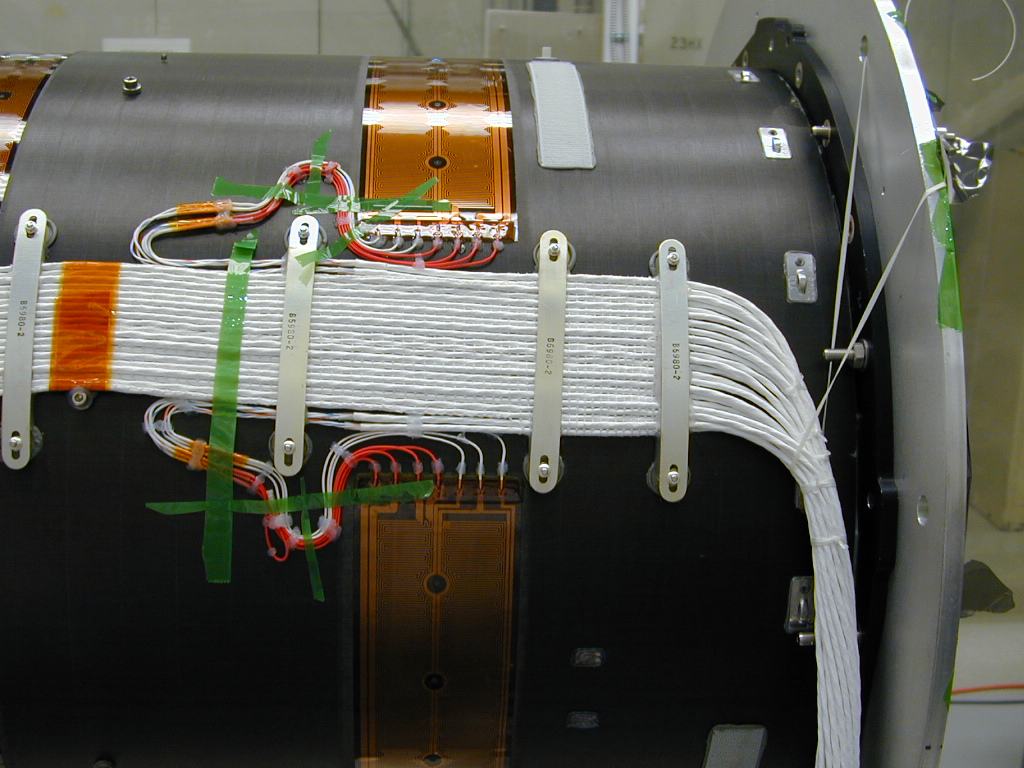
Thermal Design
Cryostat
The CCD detectors must be cooled to between -80 C and -130 C during operation to ensure low dark current and to reduce sensitivity to radiation damage. The JET-X and XMM/EPIC CCDs were passively cooled by radiators, but the Swift LEO and wide pointing requirements do not permit this option. For Swift, the CCD will be cooled by a TEC to -110 C, with the heat dumped to a radiator running at a higher temperature (-70 C), as was done successfully on ASCA, CUBIC, and Astro-E. Thermal analysis using the Ideas TMG package and laboratory studies have shown that we can achieve the required temperatures provided that the detector mounting scheme is carefully optimized.
Radiator
The radiator design is dictated by the Swift orbit and pointing constraints. The radiator is carefully configured and integrated with the external spacecraft design to achieve the required low temperature of -70 C in LEO. It consists of a single flat plate cantilevered from the rear telescope tube. The spacecraft pointing will allow one edge of the radiator to be pointed directly at the sun which will prevent direct illumination of the radiator faces by the sun. A small sun shield along the sunward edge of the radiator will allow some tolerance in the pointing requirements.
Telescope thermal design
The XRT stability required for arcsecond alignment tolerances. The heaters on the telescope tube (two heater elements are shown in the figure on the left) are thermostatically controlled to keep the tube at 20 +/- 1 C, and are placed to eliminate longitudinal and azimuthal temperature gradients that could distort the tube. This system of heaters has been extensively tested and qualified for the JET-X project. If thermal analysis in Phase B indicates that fewer telescope tube heaters are required in the more benign thermal environment of Swift, the number of control heaters will be reduced, reducing the XRT power requirements.Mirror thermal design
The mirror module must be maintained at 20 C +/- 0.5 C with gradients of less than 1 C in order to prevent degradation of its performance. The mirrors are not heated directly; instead, an actively controlled thermal baffle in front of the mirrors replaces the heat radiated to space by the mirrors. The heaters on the mirror baffle are extremely critical to the proper figure and performance of the telescope mirrors, and have been extensively tested and qualified for the JET-X. Basic thermal control is provided by a base heater connected to the survival heater bus and a control heater whose duty cycle can be adjusted from the ground to trim the total heater power based on on-orbit thermal performance. These heaters are operated from the unregulated +28V spacecraft bus, which can vary over a +/- 6V range during the life of the mission. The thermal baffle therefore includes an additional vernier heater with duty cycle controlled by the ICP to compensate for bus voltage variations.
Swift Mission Operations Center
The Pennsylvania State University301 Science Park Road,
Building 2 Suite 332,
State College, PA 16801
USA
☎ +1 (814) 865-6834
📧 swiftods@swift.psu.edu
Swift MOC Team Leads
Mission Director: John NousekScience Operations: Jamie Kennea
Flight Operations: Mark Hilliard
UVOT: Michael Siegel
XRT: Jamie Kennea
Swift Partners
UK: UCL MSSL Univ. of LeicesterUSA: NASA/GSFC LANL Omitron SwRI
Italy: SSDC/ASI INAF OA-Brera
